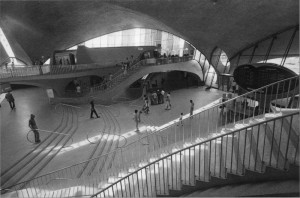 I’ve been walking the streets of the Capital over the past few days, enjoying a mini holiday. I’ve also been discovering this urban wonderland afresh through a 50 millimeter lens. On Thursday as I began to experience DC from a multi-lens perspective, I happened upon an exhibit at the National Gallery of Art featuring Garry Winogrand.
I’ve been walking the streets of the Capital over the past few days, enjoying a mini holiday. I’ve also been discovering this urban wonderland afresh through a 50 millimeter lens. On Thursday as I began to experience DC from a multi-lens perspective, I happened upon an exhibit at the National Gallery of Art featuring Garry Winogrand.
For those of you who don’t know, Garry was a still photographer, mainly working in the 60’s and 70’s, who was adept at capturing human emotion with rich metaphor as subtext. He sought to convey both the connection and fragmentation between humans, and did so mostly in his home state of New York as well as in California and Texas. He juxtaposed urban life with country fairs in ways that were startling and compelling to admirers of his work. He became a teacher of the medium, both formally and informally, and many of his photographs were unveiled posthumously (a fact that has intrigued many for the perceived implications that he was less interested in showcasing and more interested in capturing the art form).
As I meandered through the Gallery exhibit, I was struck by the dramatic switch from frames of disconnection to connection. So often both were found in the four walls of one photograph. In the middle of the exhibit, there was a detailed explanation of why he enjoyed taking pictures in airports. He considered airports to be hubs not only for arrivals and departures of planes, but also the patterned entrances and exits of human connectedness. He found those transits to be rich sources for portraying the contrast. He would see loved ones issue tearful and dramatic good-byes, then immediately exit and ignore everyone around them as they boarded planes.
It was the space between apathetic humans walking in proximity that particularly interested him, according to the exhibit. As I registered this intentional decision of his to seek out disconnection and portray it, I was struck by a thought. Where do we see that kind of fragmentation on display currently? In a post-911 world, we don’t find it in the same way in airports, at least not the juxtaposition of tearful good-byes to apathetic plane entrances.
His decision to seek out airport disconnection seemed worth pondering, so I came up with a few other places where cultural fragmentation is currently on display.
Urban streets: These streets host masses of feet committed to perpetual motion and marching in horizontal and vertical patterns, sometimes sliced across by a diagonal line, cutting the cadence of the toed rhythm. These feet are continuously kicking their way through crowded intersections, attached to legs, arms, and elbows, blocking out and defending against fellow humanity.
The fact that shoving others in a crowd is such a defensive act contributes to the cold and sterile disconnect. In order to take such a defensive posture, we have to make a decision that our agenda, needs, and desires are more important, thereby elevating ourselves and diminishing the humanity of the people around us.
Grocery stores: Where tomatoes share a common fate, but are divided by vastly different purposes depending on the purchaser. We’re all there to buy the same produce, meats, dairies, etc. but the varying combinations of utility seem to be more divisive than uniting. If I smile at people in the grocery store, or hold the door for them, or help them with their carts, I usually get a startled or confused look.
My takeaway? Connection is inherently unexpected. We’re more inclined to anticipate dodgy glances, fights over the last loaf of fresh-baked bread, or Bluetooth calls piercing the air with the hope of dialogue that just isn’t meant for us.
Have you been in Target lately? Fighting over the grocery store conveniences is extended further to clothes, home goods, electronics, and pet supplies. The larger quantity of stuff only increases the combination of decisions we have to make that leave us with a strong agenda, haphazard pathways, and little interest in interacting with others in our laser-focused task orientation.
Trains, Buses, Taxis: Maybe the new airport of disconnection comes in the form of trains and automobiles. It would seem that any invention meant to move people is also prone to silence them between point A and point B. When there is noise, it’s not directed at the kind stranger, it’s at our electronic devices. And elevators? We all know that they are champions of awkward silence designed to glue our gazes to the beyond mundane fake, wood floor, or poorly patterned carpet.
This exercise is not meant to shame or judge or even point out our flaws in engaging in these patterns. I’ve made the decision many times over to push through crowds defensively or sit in silence on a bus or fix my gaze to the elevator floor.
I have noticed, however, that the times when I do break pattern are times that are generally rewarding.
To reach out to a surrounding someone when the expected cadence is disconnection is a startling and bold act. So when we do it, we may get initial surprise or confusion, but oftentimes there’s a softening, and a remembered realization that we’re all human, and that the crowds we’re pushing through are not objects but beings. The feet we’re kicking against are not speed bumps but are lives with failures, successes, and plans of their own. The hands that are fumbling to pick out ripe produce are hands designed for work and for play, just like ours. The eyes that are shifting downwards in the elevator are beautiful, lucid, and brimming with stories, both happy and sad.
We are united by the fact that we’re people. We share common experiences, emotions, stories, failures, successes, body parts, family units, hobbies, work goals, daily routines, and the list could go on and on.
So maybe this seems basic, or soap box-esque, or unimportant, but when I share these same stories in counseling, there’s often a deep exhale.
Why is that? Because it’s normalizing. To know that we’re all people and we all experience the world in similar ways means that maybe our fears, failures, and shortcomings aren’t so very different from others. And if that’s the case, maybe it’s worth the risk of reaching out in connection during those times when connection is least expected.
I’d like to share this quote from Winogrand that is eerily applicable here:
I like to think of photographing as a two-way act of respect. Respect for the medium, by letting it do what it does best, describe. And respect for the subject, by describing as it is. A photograph must be responsible to both.
When we ignore others on sprawling, urban streets or avoid them in elevators or push past them to get produce, do we allow their humanity to be what it is? Or do we diminish it, overshadowing their personhood with the immediacy of our agendas? I believe we all want our humanity to be respected in those moments; so it seems worth the effort to respect others within a deeply self-conscious and fragile divide.

I enjoyed your framed insights on our often disconnected world. As we interact with the public, how does an observed connection influence the potential for other connections?
Thank you, Kent. I’m glad you enjoyed it. Observed connection allows us to make important judgments. Those judgments define whether or not we will choose to interact with others. They soften our defenses, or increase our resolve to avoid. They allow us, as the observers, to scope the terrain and make informed decisions about whether or not to engage in connection.